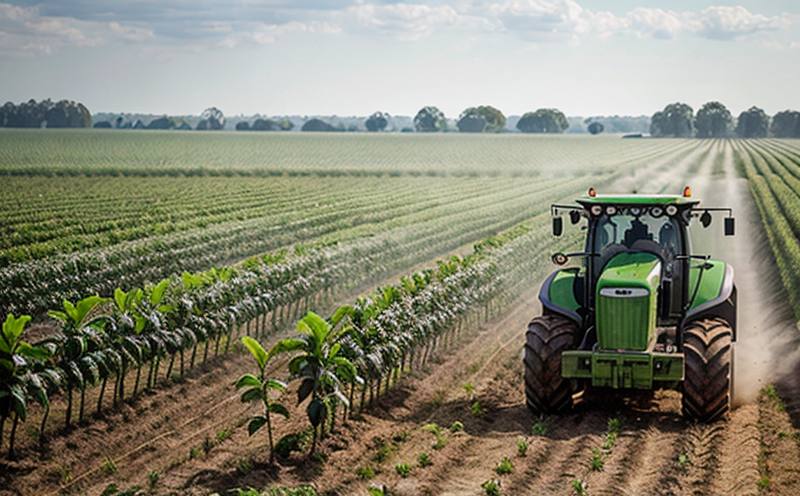AOAC 98425 Dye Residue Testing in Agricultural Products
The AOAC Official Method 984.02 (formerly known as AOAC 984.25) is a widely recognized analytical procedure designed to determine the presence and quantify dye residues in agricultural products, including fruits, vegetables, grains, and other food items of plant origin. This method employs high-performance liquid chromatography (HPLC) with ultraviolet-visible detection for accurate quantification.
Given the increasing scrutiny on the use of dyes and colorants in agricultural products to enhance appearance or extend shelf life, AOAC 98425 provides a reliable means to ensure compliance with regulatory standards. This service is particularly relevant for quality managers, compliance officers, R&D engineers, and procurement teams who need to verify that their supply chain adheres to strict dye residue limits.
The process begins with the collection of representative samples from various batches or lots of agricultural products. Samples are then prepared by homogenization followed by extraction using a suitable solvent, typically methanol or acetonitrile, ensuring complete dissolution of any dye residues present. The extracted solution is filtered to remove particulate matter and subsequently analyzed via HPLC.
Instrumentation used in this method includes an HPLC system equipped with a UV detector and a gradient mobile phase. Chromatographic conditions are optimized for the separation of dyes, which can vary widely in chemical composition. The retention times and peak areas obtained from the analysis are compared against calibration standards to determine dye concentrations.
The results generated by this method provide critical insights into potential contamination issues that could arise from unauthorized or excessive use of dyes during production processes. Compliance with regulatory limits helps protect brand reputation, consumer health, and market access for agricultural products.
For accurate implementation of AOAC 98425, it is essential to follow standard operating procedures meticulously. This includes proper sample preparation, calibration of the HPLC system, and adherence to strict quality control measures throughout the analytical process. The method's robustness ensures consistent results across multiple batches and operators.
The significance of dye residue testing extends beyond mere regulatory compliance; it also plays a crucial role in safeguarding public health by preventing exposure to potentially harmful substances. By adhering to AOAC 98425, laboratories contribute significantly to maintaining the integrity and safety of agricultural products consumed worldwide.
Why It Matters
The importance of dye residue testing in agricultural products cannot be overstated, especially given the global trend towards healthier living and increased awareness regarding food safety. Regulatory authorities around the world have established maximum allowable limits for certain dyes to ensure they do not pose health risks when consumed.
Dye residues can originate from various sources such as accidental contamination during processing or intentional use to enhance visual appeal, extend shelf life, or mask imperfections. Accurate detection and quantification of these residues are vital in preventing their accumulation at levels that could exceed safe thresholds.
For quality managers and compliance officers, ensuring adherence to regulatory requirements is paramount. AOAC 98425 serves as a trusted tool for meeting these obligations, providing peace of mind regarding product safety and marketability. R&D engineers benefit from this method by gaining insights into potential issues related to dye usage, which can inform future product development decisions.
Procurement teams also find value in AOAC 98425 as it helps them source products from reliable suppliers who comply with stringent quality standards. By implementing this testing protocol, organizations demonstrate their commitment to maintaining high ethical and safety standards within their supply chains.
Applied Standards
| Standard | Description |
|---|---|
| AOAC Official Method 984.02 (AOAC 98425) | High-performance liquid chromatography with UV detection for quantification of dye residues in agricultural products. |
| ISO 17025 | Laboratory accreditation ensuring competence and reliability of testing processes. |
| Standard | Description |
|---|---|
| ASTM E3016 | Guidelines for the evaluation of performance in laboratories performing chemical analysis. |
| FDA 21 CFR Part 11 | Requirements for electronic records and signatures to ensure integrity during testing processes. |
The application of these standards ensures that the AOAC 98425 method meets rigorous quality control criteria, enhancing confidence in its reliability and accuracy. Compliance with such standards also facilitates seamless integration into international regulatory frameworks, making it easier for businesses to comply across multiple jurisdictions.
Quality and Reliability Assurance
The AOAC 98425 Dye Residue Testing service at our laboratory is underpinned by a robust quality management system that adheres strictly to international standards. Our team of experienced analysts ensures consistent performance through strict adherence to standard operating procedures (SOPs).
Quality assurance measures include regular calibration of HPLC equipment, participation in proficiency testing programs, and continuous training for staff on the latest analytical techniques. These efforts guarantee accurate and precise results every time.
In addition to methodological rigor, we maintain strict chain-of-custody protocols for all samples processed under AOAC 98425. This ensures traceability from sample receipt through final reporting, reducing the risk of errors or misinterpretation at any stage.
The reliability of our testing services is further enhanced by stringent quality control checks performed at various points within each analytical cycle. These include internal audits and external reviews conducted periodically to verify compliance with established protocols and standards.
Our commitment to excellence extends beyond technical proficiency; we also prioritize customer satisfaction through timely communication and transparent reporting practices. Clients receive detailed reports outlining findings alongside recommendations for corrective actions if necessary.





